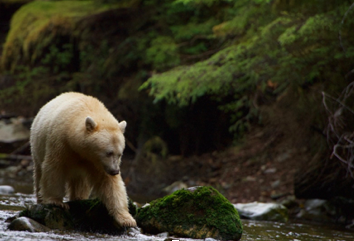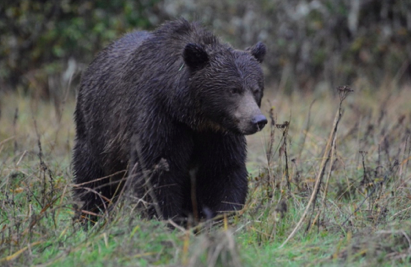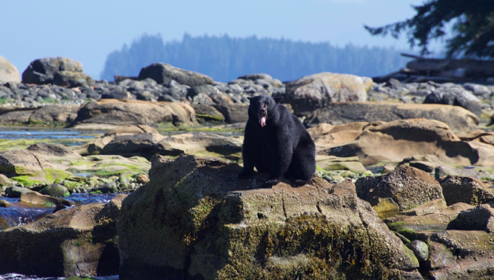Bears (grizzlies in particular) are often misunderstood. Movies like Legends of the Fall make grizzlies out to be giant, blood-thirsty carnivores seeking revenge on humans. The media also loves a good bear-mauling story and tend to stretch the truth. These stories commonly don’t include the human-error side of things- as in what hikers, campers, hunters, and fishermen are responsible for while traveling in bear country and how to prevent conflict in the future. In reality bears are just as fearful of us as we are of them. Their diet does include meat in the form of fish, insects and mammals, but largely consists of vegetation and berries. It is extremely rare that a bear has a taste for humans. Some people view bears as cute and cuddly which is also far from the truth. The last thing a bear wants from us is a hug. This inaccurate information only feeds these misconceptions, creating more fear leading people to believe we are in grave danger every time we see a bear or travel through bear habitat.
Misconceptions
Although the list is long, here are a few common misconceptions about bears:
* When people see a grizzly they typically assume it is a ‘huge male’ and must weigh close to 1,000 pounds. It is common for humans to want to believe when they see a carnivore it is the biggest one on the landscape. Although brown bears can weigh over 1,000 pounds in some cases, their weight fluctuates significantly based on the ecosystem and time of year. The average weight for a male grizzly in the Greater Yellowstone Ecosystem is between 300-700 pounds and 200-400 pounds for females.
A male and female adult grizzly side by side. (Photo by Blakeley Adkins)
*When people see a bear standing on its hind legs they usually assume it is going to charge them or is acting aggressively. In reality they are simply trying to get a better idea of something that they have heard, seen, or smelled. It is a far better vantage point than standing on all fours. You will often see cubs standing on their hind legs due to their size and curiosity, or larger bears picking up on another bear’s scent in the area or a human close by and doing the same.
Young cub standing to get a better view. (Photo by Blakeley Adkins)
*Charging and vocalization is often thought to lead to an attack. This is rarely the case. Coming into physical contact with a human or another bear expels a lot or energy and not something a bear does unless it thinks it’s necessary. Bears will bluff charge one another to show dominance and try to move another bear out of the area and they will do the same to people. Sometimes confident bears will expect you to move out of the way first when you are sharing a trail or road. It is a good idea to do so if this happens but does not mean an attack is inevitable simply because the bear wants you to move along. Vocalizations can mean a variety of things including stress, fear, anger, hunger, distress, or surprise. This can be in the form of “huffing” or “chuffing”, teeth popping, and bawling, but vary rarely the roaring that you hear in the movies.
*Black bears are often viewed of as a non-threat while grizzlies are seen as dangerous and aggressive. These assumptions are due to the fact that black bears evolved in forested habitat where they typically had thick cover to run into or a tree to climb when they encountered a threat. Because of this they have curved claws which aid in climbing trees. This common behavior does not mean black bears are not capable of hurting you or will always run away from you. We should remember that they can act aggressively, occasionally harm and even kill humans, and should give them the space and respect they deserve. Grizzlies on the other hand evolved in open plain habitat which is why they often stand their ground when they encounter a threat. As humans we are used to having wildlife backdown first which is not always the case with grizzlies. They humble us which I why they are an important species to keep around.
*Grizzlies and Kodiaks fall into the same species which is universally called brown bears (Ursus arctos). Black bears (Ursus americana) range from cinnamon to jet black to white in color but are all the same species as well. Size and color are not accurate ways to identify bear species.
A white black bear also known of as a spirit bear or Kermode (photo by Blakeley Adkins)
A female dark brown bear
Bear Behavior
Bears express themselves through body language when they encounter another bear. Posturing, the direction their ears are facing, their stance, where they are looking, and their movements all communicate a mood and social rank to another bear. A bear that is swatting the ground with its ears back and looking directly at another bear is conveying a very different message than one which is looking away from another bear with its ears perked up and head down. Bears use this same body language when they encounter humans. They are testing their dominance and determining who will be the one to back down first. Knowing how to read into this behavior is important, will make you less fearful and allow you to act accordingly when you encounter bears in the future. If you are a dog owner you will notice many similarities between dog behavior and bear behavior. Many people think bears are unpredictable, but if you are able to read their body language you will realize this is not the case.
This black bear looks angry but is actually just yawning.
Be Bear Aware
The best thing we can do when traveling in bear country is make noise to alert bears of your presence. A human voice is the best method as a bear bell, clapping, whistling and banging sticks together is noisy but can be confused with something other than a person. Secondly, always carry bear spray. A gun is not a bad thing if you know how to use it and it makes you feel safe, but bear spray is non-lethal, easier to aim, and proven to be far more effective than a firearm. Thirdly, educate yourself on bear ecology and bear behavior. Lastly, be aware of bear attractants and how to properly manage them when recreating or living in bear country. This includes food, garbage, livestock, carcasses, fruit trees, bird seed, and vegetable gardens. Bears are food focused and your ability to control the situation will be far less when food is involved. Further information on this and more can be found at: http://www.bearsmart.com/
Written by: Blakeley Adkins, TMBA





